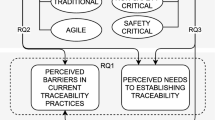Abstract
Requirements traceability offers many benefits to software projects, and it has been identified as critical for successful development. However, numerous challenges exist in the implementation of traceability in the software engineering industry. Some of these challenges can be overcome through organizational policy and procedure changes, but the lack of cost-effective traceability models and tools remains an open problem. A novel, cost-effective solution for the traceability tool problem is proposed, prototyped, and tested in a case study using an actual software project. Metrics from the case study are presented to demonstrate the viability of the proposed solution for the traceability tool problem. The results show that the proposed method offers significant advantages over implementing traceability manually or using existing commercial traceability approaches.







Similar content being viewed by others
References
Armbrust, O., Ocampo A., & Soto, M. (2005). Tracing process model evaluation: A semi-formal process modeling approach. In ECMDA traceability workshop (ECMDA-TW) 2005 proceedings (pp. 57–66). Nuremberg, Germany.
Brown, A. (2004). Oops! Coping with human error in IT systems. Queue, 2(8), 34–41.
Cleland-Huang, J. (2006), Just enough requirements traceability. In Proceedings of the 30th annual international computer software and applications conference (COMPSAC’06) (pp. 41–42).
Cleland-Huang, J., Chang, C., & Christensen, M. (2003). Event-based traceability for managing evolutionary change. IEEE Transactions on Software Engineering, 29(9), 796–810.
Egyed, A., & Grunbacher, P. (2002). Automating requirements traceability: beyond the record and replay paradigm. In Proceedings of the 17th IEEE international conference on automated software engineering (pp. 163–171). Edinburgh, United Kingdom.
Gills, M. (2005). Software Testing and Traceability. University of Latvia. http://www3.acadlib.lv/greydoc/Gilla_disertacija/MGills_ang.doc.
Gotel, O., & Finkelstein, A. (1994). An analysis of the requirements traceability problem. In Proceedings of the first international conference on requirements engineering (pp. 94–101). Colorado Springs, CO.
Hayes, J., & Dekhtyar, A. (2005). Humans in the traceability loop: Can’t live with ‘Em, can’t live without ‘Em. In Proceedings of the 3rd international workshop on traceability in emerging forms of software engineering, (pp. 20–23). Long Beach, CA.
International Council on Systems Engineering. (2008). INCOSE requirements management tools survey. http://www.paper-review.com/tools/rms/read.php.
Jarke, M. (1998). Requirements tracing. Communications of the ACM, 41(12), 32–36.
Lempia, D., & Miller, S. (2006). Requirements engineering management, presented at the 2006 National Software and Complex Electronic Hardware Standardization Conference, Atlanta, GA.
Lungu, N., & Muvuti, F. (2004).Service oriented architecture for a software traceability system. Technical Report CS04-14-00, Department of Computer Science, University of Cape Town.
Munson, E., & Nguyen, T. (2005). Concordance, conformance, versions, and traceability. In Proceedings of the third international workshop on traceability in emerging forms of software engineering (pp. 62–66). Long Beach, CA.
Naslavsky, L., Alspaugh, T., Richardson, D., & Ziv, H. (2005). Using scenarios to support traceability. In Proceedings of the third international workshop on traceability in emerging forms of software engineering (pp. 25–30). Long Beach, CA.
Ramesh, B. (1998). Factors influencing requirements traceability practice. Communications of the ACM, 41(12), 37–44.
Ramesh, B., & Jarke, M. (2001). Toward reference models for requirements traceability. IEEE Transactions on Software Engineering, 27(1), 58–93.
Spanoudakis, G., Zisman, A., Perez-Minana, E., & Krause, P. (2004). Rule-based generation of requirements traceability relations. Journal of Systems and Software, 72(2), 105–127.
Telelogic. (2008). Telelogic DOORS—requirements management for advanced systems and software development. http://www.telelogic.com/products/doors/doors/index.cfm.
Young, R. (2006). Twelve requirement basics for project success. CrossTalk The Journal of Defense Software Engineering, 19(12), 4–8.
Author information
Authors and Affiliations
Corresponding author
Rights and permissions
About this article
Cite this article
Saiedian, H., Kannenberg, A. & Morozov, S. A streamlined, cost-effective database approach to manage requirements traceability. Software Qual J 21, 23–38 (2013). https://doi.org/10.1007/s11219-011-9166-3
Published:
Issue Date:
DOI: https://doi.org/10.1007/s11219-011-9166-3



